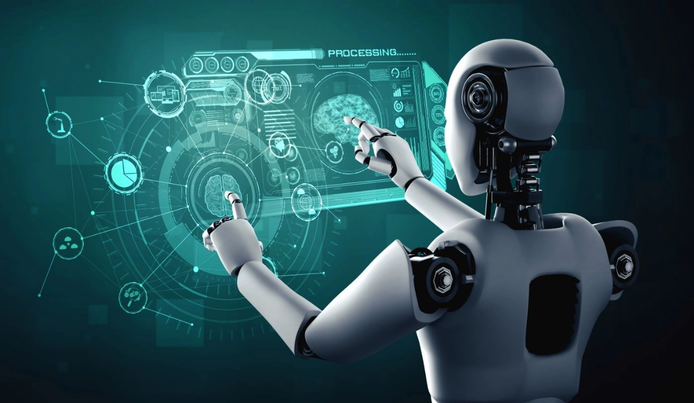Accelerating Intelligent Automation In The Banking Industry To Transform Processes
Intelligent Automation continues to evolve at an unprecedented rate. This cutting-edge technology has a huge potential to transform how organizations of various industries operate. Specifically, IA offers several tangible benefits for banks and their customers in the banking industry.
What is Intelligent Automation?
Intelligent Automation (IA) is the combination of Robotic Process Automation (RPA), Artificial Intelligence (AI), and other advanced technologies such as Machine Learning (ML), Intelligent Document Processing (IDP), and Process Mining to extend the scope of automation.
IA is the next automation evolution of RPA. While RPA only handles rule-based and repetitive tasks, IA can leverage the automation capability of RPA and integrate it with AI to augment human thinking and conditioning logic. This facilitates IA to perform more complex tasks that require learning, judgment, analysis, and decision-making without human intervention.
The adoption of Intelligent Automation in the Banking industry
Notably, to remain relevant and competitive in the new landscape, many banking organizations have acknowledged the potential of IA and started to implement IA for improved efficiency and productivity.
A 2019 report revealed that IA was adopted by nearly 85% of banks to leverage core functions. According to Gartner, 80% of financial leaders have adopted or plan to adopt RPA in their business processes. A survey by the World Economic Forum in 2020 indicated that 85% of financial organizations were integrating AI into their business functions. IDC also predicts that banking’s investment in AI will accelerate, securing the second-largest industry for AI spending. Besides, a report by Accenture reveals that implementing Intelligent Automation in the Banking industry could help banks achieve annual cost savings of up to $70 billion by 2025. The impressive statistic shows the remarkable potential of Intelligent Automation in the Banking industry.
Some common use cases of Intelligent Automation in the Banking industry include:
Account opening and onboarding
With Intelligent Automation, account opening and onboarding processes can be automated, allowing for rapid onboarding. These processes include data entry, customer data verification, and KYC (Know Your Customer).
- RPA to extract crucial information from various documents
- Intelligent Document Processing (IDP) to check and verify customer information from multiple databases and platforms (structured/unstructured)
- Machine Learning to spot any potential risks
Loan application
The traditional paper-based loan applications can now be enhanced with Intelligent Automation by automating data collection, credit risk assessment, and document verification.
- IDP to extract and verify customers’ data
- RPA and AI to consolidate internal and external documents for evaluation ready for the loan decisions
- ML-based credit scoring models to enhance the accuracy rate of the loan final decisions
Anti-Money Laundering prevention
An employee often needs to spend 30 minutes or more on a single Anti-money laundering (AML) investigation depending on the complexity and availability of information. However, the adoption of Intelligent Automation enables banks to comply with AML regulations much faster and with greater accuracy, facilitating a more transparent operation.
- RPA to collect customer data from multiple databases
- IDP and AI algorithms to compare and track customer data, account statements, and transactions and report any suspicious transactions or activities
- If there is any sign of patterns outside the safe zone, activities can be flagged and alerts generated to the security department
Customer service
By automating the manual processes, IA can help banks to offer faster and more efficient service. With AI, banks can also learn customer’s behaviors and needs, thereby recommending tailored products and services for customers.
Besides, AI-led chatbots powered by RPA can handle customer queries more efficiently, and engage customers in more natural conversation and contextually relevant responses with Natural Language Processing capability. Intelligent chatbots can also offer 24/7 customer service, reducing the waiting time and ensuring customer engagement and loyalty.
Regulatory compliance
Intelligent bots allow banks to meet complex regulatory requirements and mitigate risk without much human intervention.
- RPA to monitor compliance-evidencing and audit trails
- RPA and AI to track regulatory announcements for upcoming changes
- IDP and NLP to scan and process legal and regulatory documents
Benefits of Intelligent Automation in the Banking Industry
There are several benefits that Intelligent Automation offers for banks and their customers. Banks that choose IA to integrate their front and back offices can achieve end-to-end process efficiencies that enable them to excel against competitors.
Increase efficiency and productivity
Achieving optimal efficiency and productivity is crucial for banks to stay competitive in the ever-changing landscape. With the help of Intelligent Automation, banks can now process a considerable amount of data and documents, including unstructured data that represent 85% of organizational data.
According to Construction Robotics, robots can handle specific tasks more efficiently than humans, about 5 times faster. This allows businesses to maximize efficiency and productivity and significantly improve process speed. The survey by Deloitte reveals that fintech organizations that implemented IA reported a 12% increase in productivity.
Enhance accuracy
According to the study “The Impact of Poor Data Quality on the Typical Enterprise”, around 1-5% of data error rates are common in business data.
By utilizing AI and machine learning algorithms, errors are eliminated compared to traditionally manual processes done by humans, which helps banking organizations reduce the risk of transactional errors and prevent faulty decision-making that greatly affects the business as a whole.
Save time
By implementing IA, banks can cut down time spent on mundane tasks reduce process handling times, and free up employees from repetitive tasks to emphasize high-value activities, such as client interaction and account management. Accenture suggests that with the implementation of IA, banks can notably save up to 90% workforce’s time.
Reduce costs
Intelligent Automation can lead to cost savings for businesses. By automating routine tasks, banks can save tremendous resources and labor costs. Deloitte research indicates that with IA adoption, businesses can enjoy a cost reduction from 25% to 40% on average.
Enhance customer experiences
With the advent of IA, banks can now able to leverage automation to both backend and front-end processes. The use of Natural Language Processing (NLP) and virtual chatbots powered by AI has facilitated banks to provide superior customer support while minimizing call and response waiting times.
IA can also serve as a powerful tool to maximize customer journeys by offering tailored products/services to customers’ queries based on Machine Learning algorithms to continuously learn particular customers’ behaviors and needs.
Hence, banks are not only able to improve customer satisfaction but also create a seamless experience for customers that could result in increased revenue and customer loyalty.
Reinforce security
Intelligent Automation implementation can be leveraged to prevent fraud with the help of Machine Learning algorithms to autonomously learn patterns of transactions. IA can efficiently verify large amounts of customer data and transactions in real-time, assess threats in business systems, and notify humans in charge if there are signs of suspicious activities, thereby minimizing potential risks, and ensuring high-security levels.
What is the future of Intelligent Automation in the Banking industry?
In addition to the benefits mentioned above, IA will continue to thrive at an unprecedented rate, further enhancing its strength to accelerate end-to-end processes for banks. akaBot x IDC’s report states that by 2024, more than 90% of organizations will adopt automation at various levels in various processes to adapt to the changing needs of the market.
The future of IA is exciting, facilitating new sources of growth and innovations. With the integration of Machine Learning and Natural Language Processing, it is expected to see huge advancement in IA, making it a strategic goal for banks to achieve operational excellence in a digital-first world.
Improved Machine Learning
Machine Learning integrated into the IA solution will become increasingly sophisticated, ensuring efficient data processing and management. By utilizing Machine Learning algorithms, banks can gather, organize, track, analyze, and store insightful data in the centralized database. This data can be used to generate actionable insights from customer data, market trends, and business operations. This helps banks accelerate existing operations, make actionable decisions to address issues promptly, and make better forecasts to develop new products and growth opportunities.
Enhanced Natural Language Processing (NLP)
NLP will have a wider range of applications in the banking industry, increasingly evolving to streamline operations and improve decision-making. NLP can assist in understanding the context, interpreting complex language more accurately, and allowing banks to analyze and process unstructured data and identify new ways to make improvements to products and services.
Cloud-based automation
Cloud-based automation solutions will allow banks to automate their manual business processes in the cloud. This helps ensure optimal performance, and scalability, and maximize resources while reducing the need for managing complex and costly infrastructure.
Significantly, a crucial consideration for Intelligent Automation adoption is the readiness of the entire organization. Achieving a comprehensive transformation requires C-level support, business alignment, resources, and cooperation from executives as a whole.
For the C-levels:
- Develop a clear goal for how Intelligent Automation should be incorporated into the bank’s operations and cascade that vision from the top down
- Provide relevant training and support to help employees at all levels feel enthusiastic about automation
- Focus on investments that modernize the technology infrastructure and develop a plan that supports the deployment of Intelligent Automation solutions
- Establish a unified process that facilitates the harmony of data, technology, and people
- Manage and monitor the effectiveness of IA solutions in all operations
For the IT department:
- Learn to adapt to the new technological landscape and understand the requirements of effective Intelligent Automation implementation
- Identify which processes and activities can be best automated to avoid siloes
- Develop a comprehensive technology infrastructure that encourages rapid deployment of new technologies
- Test the systems and identify potential failure modes and limitations
- Coordinate with other departments to scale IA across the organization
For the executives:
- Acquire new skills to better sync with the advanced automated technologies
- Focus more on the potential gains that Intelligent Automation brings to the enterprise
- Learn to adapt to changes as it makes room for growth and innovation
Conclusion
Analytics Insights predicts that the global Intelligent Automation market will reach US$19.6 billion in 2024, at a Compound Annual Growth Rate (CAGR) of 14.5% . In recent years, IA has grown considerably, offering opportunities for banks to optimize their operations and stay ahead of the curve. More and more organizations have started to adopt IA solutions for enhanced productivity, cost reduction, and seamless customer experience.
Therefore, to become an IA-first bank, banking institutions, and financial leadership need to prepare for changes across the organization from strategy and vision to processes, skills, infrastructural support, and culture.
Exclusive article by FPT IS Technology Expert
Duong Viet Tung
akaBot COO, FPT IS














